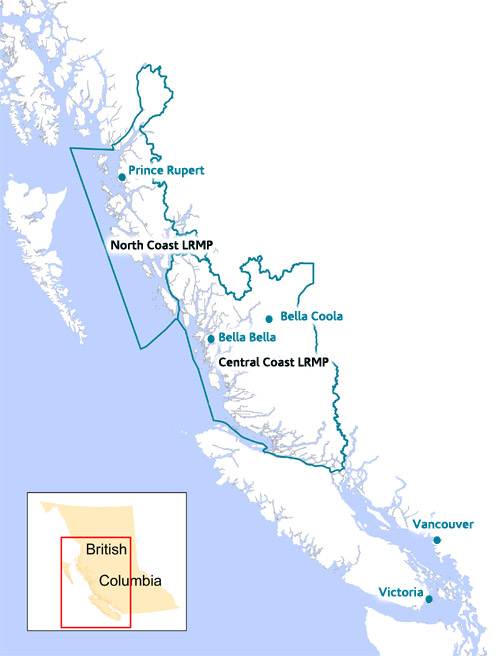|
The efforts of the Coast Forest Conservation Initiative are focused on the region known as the Great Bear Rainforest. The 64,000 square kilometer region (25,000 square miles) includes the Central Coast and North Coast of British Columbia. The environmentally and culturally rich region is the traditional territory of twenty-seven First Nations.
The region provides much of the wealth for communities as diverse as Prince Rupert and Bella Coola, where commercial logging on a small percentage of the land base has provided employment and economic development for more than a hundred years.
The region also supports one of the largest areas of coastal temperate rainforest in the world, providing habitat for a significant diversity of wildlife including the unique Kermode bear, grizzly bear, mountain goat and coastal wolves. The rivers, streams and estuaries provide spawning and rearing habitat for five species of Pacific Salmon, as well as breeding grounds for migratory waterfowl and myriad other bird species. The World Wildlife Fund has ranked this region globally outstanding due to its biological diversity and the global rarity of the ecosystem type.

[return
to top]
Central Coast
The Central Coast planning area encompasses 4.8 million hectares (11.8 million acres) of land, fresh water and marine area. Extending west from the Coast Mountains, it spans the mainland coast of British Columbia from Bute Inlet in the south to Douglas Channel in the north.
The region is home to more than 4,400 people, mainly First Nations. Natural resource industries, including fisheries and forestry, play an important role in local economies and the wellbeing of communities such as Bella Bella, Shearwater, Ocean Falls, Klemtu, Bella Coola and Oweekeno.
The Central Coast is ecologically diverse, characterized by rugged mountains, deep ocean fjords, numerous islands and long alluvial valleys reaching into the interior ecosystems of the province. Coastal temperate rainforests dominate lower elevation landscapes. These forests, as well as the wetlands, bogs, estuaries and rivers found throughout the region, are biologically dynamic and rich in biodiversity.
About half the area is forested, while less than 12 percent contains commercial forests available for timber harvesting. The Central Coast Land and Resource Management Planning process recommended that one third of the area be set aside to protect biodiversity and cultural values, with the remainder of the region available for ecosystem-based management. Following the Coast Land Use Decision commitment to fully establish an EBM system for the Great Bear Rainforest announced March 31st 2009, the focus shifted to development of strategies to improve human well-being and the creation of a strategic landscape reserve design; designation of Grizzly Bear no-hunting areas; concluding conservancy management planning; and improving legally-binding Land Use Objectives with results from an adaptive management
[return
to top]
North
Coast
Covering 1.7 million hectares (4.2 million acres), the North Coast planning area lies to the north of the Central Coast and stretches from Douglas Channel to Stewart and the border with Alaska.
Approximately 17,000 people live within the North Coast region, most in the city of Prince Rupert, and the remainder in the communities of Port Edward, Metlakatla, Lax Kw'alaams, Kitkatla and Hartley Bay. All these communities lie next to the sea and draw their wealth from marine resources, forestry and tourism.
The North Coast includes predominately maritime ecosystems that represent a diversity of habitat types and ecological complexes. Approximately 38 percent of the area is forested, and less than six percent is available for timber harvesting.
The North Coast Land and Resource Management Planning process recommended that about one third of the area be set aside to protect biodiversity and cultural values, with the remainder of the region available for ecosystem-based management. Since then designation of new parks and protected areas have increased protection for rare ecosystems, freshwater shorelines and fish habitat.
[return to top]
|